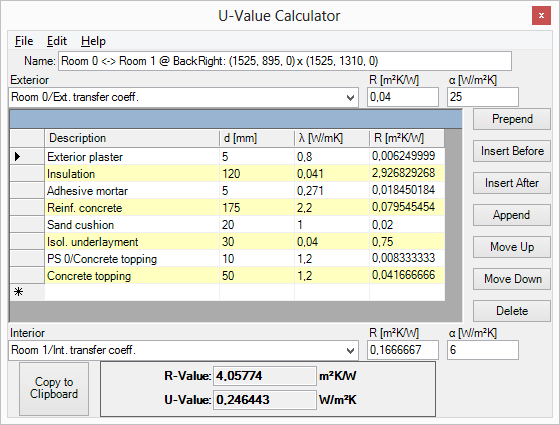U-Value Calculator
The U-Value Calculator is used for rapid calculation of U-Values for layered constructs.
Data of the layered structure can be saved into a layered construct file (

A layered construct contains a list of material layers surrounded by two surface (exterior and interior) boundaries.
For the two surface boundaries one can enter its surface heat transfer coefficient or transfer resistance. The Menu Edit→Surface transfer coeffs provides a choice of normative standard values. Both name fields of exterior and interior surfaces also provide same choices of standard normative values:The reciprocal value of the sum of resistances of all material layers and both surface transfers are displayed in the U-Value field.
Actually selected data line is marked by an arrow symbol at its left (data record mark). Multiple selection is also possible (e.g. for deletion of line which can be initiated with DEL key).
The complete layered construct can be placed onto the clipboard by the menu function Edit→Copy to be pasted later.
Tool specific control elements
Insert: Inserts a new layer at the top of material layers list
Insert Before: Inserts a new layer before the one currently selected
Insert After: Inserts a new layer after the one currently selected
Append: Appends a new layer at the bottom of material layers list
Move Up: Moves the selected data line one position towards top of material layers list
Move Down: Moves the selected data line one position towards bottom of material layers list
Delete: Deletes the currently selected data line from material layers list
Tip: To delete data line selected press the DEL key
Remark:Pressing DEL key will delete all selected lines
Copy to Clipboard: A copy of current layered construct (all layers and the result) are placed onto the clipboard. Data placed onto the clipboard are are available there in different formats: complete layered construct, which can be pasted back into U-value calculator, tabulated text data of layered construct available for insertion into another application (z.B. MS Excel).
Even if the order of layers and the inside/outside orientation do not matter for the calculation of the U-Value one can reorder layers within this tool as needed.
Tool specific menus
Menu items specific to this tool are presented in the main menu of the application:
File→New Creates a new, empty, structure of a layered construct. Warning: Save data prior to requesting this function!
File→Open... Allows loading data of material layers ( File→Save... Allows storing the data of a layered construct into separate file ( File→Exit Closes the U-Value calculator window
Warning: Save data prior to requesting this function! Edit→Copy A copy of current layered construct (all layers and the result) are placed onto the clipboard. Data placed onto the clipboard are are available there in different formats:
complete layered construct, which can be pasted back into U-value calculator,
tabulated text data of layered construct available for insertion into another application (z.B. MS Excel). Tip: To copy the resulting U-Value to the clipboard alone use the context menu f the respective result field (you reach this menu by pressing the right mouse button over the field). Edit→Paste The construct currently on the clipboard can be pasted (inserted) into the current one. Edit→Surface transfer coeffs→... Provides a choice of normative standard values of surface transfer coefficients designed for interior and exterior surfaces.
The list offers standard value pairs from EN ISO 6946:1996 and EN ISO 13788:2002.
